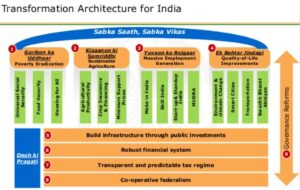Prime Minister Narendra Modi said ‘Sabka Saath, Sabka Vikas, Sabka Vishwas’ is the “basic mantra” of the government in its mission to work for the country and its development. ‘Together, for everyone’s growth, with everyone’s trust’ also resonates with the core SDG principle of leaving no one behind.
Dimensions
- Development for all framework
- Transformative architecture
- Achievements to date
- Road ahead
Content:
Development for all framework:
- This framework aims to ensure a better life for all. For this, the benefits of development should reach the poorest.
- The strategy of “Development for All Framework’ is to build India’s productive capacity through an investment-driven suppl-side Approach
- The strategy is hinged on building
- Hard Assets: Like transportation, manufacturing, Power, Housing and Telecom
- Soft Assets: like Education, Skill Building, Judicial system, Regulatory Institutions, and Entrepreneurial Ecosystem
The core principles of the framework are:
- Pro-Poor: Povert eradication as a moral imperative
- Pro-Market: Pro COmpetition and innovation
- Empowerment not entitlement
- Minimum government maximum governance – Rule based, Policy driven decision making
- Strengthen Team India – through Cooperative Federalism
Transformative Architecture
The architecture of the ambitious goal will be on the following pillars:
- Sabka Saath Sabka Vikas
- Poverty Eradication (Garibon ka uddhaar): through universal social security, Food security and housing for all
- Sustainable Agriculture (Kisaan ki Samriddhi): through enhancing agricultural productivity, crop insurance & financing and Minimum Support Prices (MSP)
- Massive Employment Generation (Yuvaon ko Rojgaar): through Make in India, Skill India, Start-up Stand-up India and MUDRA
- Improving Quality of Life (Ek Behtar Zindagi): Through mitigating Environemnt & Climate change, smart cities, transportation and Swachh Bharat Abhiyan
- National Development ( Desh Ki Pragati)
- Building infrastructure through public investments
- Robust financial system
- Transparent and Predictable tax regime
- Cooperative federalism
- Governance Reforms

Achievements to date:
Development for All
- Banking for All
- Jan Dhan Yojana Serving the Banking Needs of the Unbanked
- 34.03 Crore Jan Dhan Accounts Opened
- India Post Payments Bank takes the banking system to the doorstep of the poor & unbanked. Over 1.25 Lakh Access Points rolled out in 4 months
- Direct Benefit Transfer Ensuring Money in Account, Removing Middlemen
- Insurance to poor
- 14.64 crore persons insured under PM Suraksha Bima Yojana at ₹12 per year
- PM Jeevan Jyoti Bima Yojana benefitted 5.67 crore families at ₹330 per year
- Financial security of senior citizens with PM Vaya Vandana Yojana, gives 8% interest for 10 years. Investment limit doubled to ₹15 lakh and scheme extended till 2020
- Sanitation for all
- Swachh Bharat Mission Brings about a Sanitation Revolution
- Rapid construction of toilets ensuring dignity of women & eradicating open defecation
- Over 5.48 lakh Villages in 27 States & UTs declared Open Defecation Free
- Sanitation coverage increased from 38.70% in 2014 to 98.82% at present
Sustainable Agriculture
- Increased Budgetary Allocation
- Farm Credit Target raised to ₹11 lakh crore for 2018-19
- ₹2,000 cr for Agri-market infrastructure fund set up
- Corpus of ₹10,000 cr to create infrastructure in fishery, aquaculture and animal husbandry sectors
- ₹1,290 cr allocated under National Bamboo Mission to help setting up small industries
- Crop Insurance
- Relief to farmers in distress given in case of 33% and more damage to the crop; earlier it was for 50%
- For food grains damaged due to excessive rainfall, full minimum support price to be paid
- Families of the deceased persons to be given an assistance of ₹4 lakhs, up from ₹2.5 lakhs
- 82% rise in provision under SDRF during 2015-20, as compared to 2010-15. It went up to ₹61,220 Crore from ₹33,580.93 Crore
- Fertilizer and Irrigation
- Pradhan Mantri Krishi Sinchai Yojana: Over 32.47 lakh hectare covered under micro irrigation since 2015-16 and Facilitating farmers for installing solar water pumps in field irrigation
- Urea 100 % Neem Coating resulted in improvement in soil health, reduction in pest and disease attack.
- This Led to Increased Nitrogen Use Efficiency and increased crop yield
- Significant increase in Urea Production with New Urea Policy
- Farmer Income Support
- PM Kisan Samman Nidhi Yojana (PM-KISAN): 12 crore marginal farmers to be provided with yearly income of ₹6000
- Interest subvention of 2% during disaster to be provided
- 2% interest subvention for Animal husbandry & Fisheries activities; additional 3% in case of timely repayment
Road ahead:
The development agenda has a long way to go to achieve the intended targets. SOme of the important areas of concern are as follows:
- Affordable housing for all specially for poor and urban middle class
- Deepening and Expansion of social security schemes to reach all marginalised sections of the society
- Strengthening agriculture through market reforms and better irrigation
- Banking reforms and enhancing resiliency of financial system from systemic risks like rising NPAs
- Simplification of the Goods and Service Tax (GST)
Mould your thought: What do you understand by the slogan Sabka Sath – Sabka Vikas – Sabka Vishwas? Has the programme able to achieve its targets? Comment.
Approach to the answer:
- Introduction
- Discuss the meaning of the slogan
- Write about the targets and their achievement briefly
- Discuss the way forward
- Conclusion
















